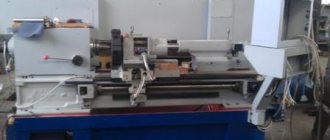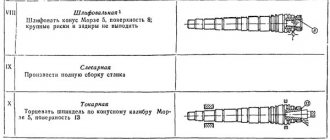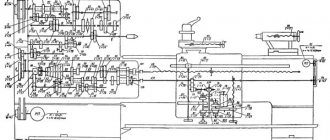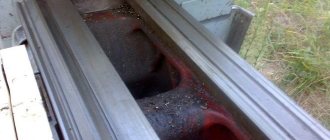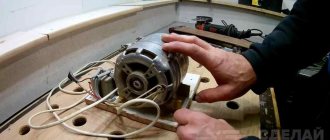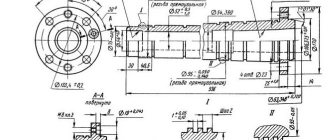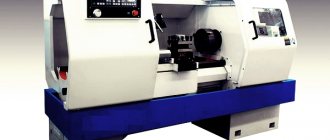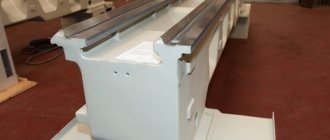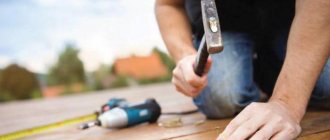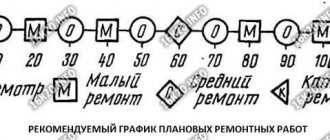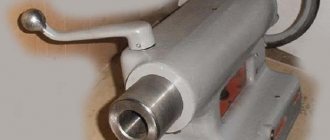How to scrape a lathe bed - Machine tools, welding, metalworking
Do-it-yourself assembly of guides and carriages for a CNC machine
During a major overhaul of a lathe, the accuracy of the bed guides is restored. When choosing a restoration method, they are guided by the degree of wear. When the error does not exceed 0.15 mm over a length of 1000 mm, they are restored by scraping. With greater wear, they resort to mechanical treatment: grinding or planing. When the guides are hardened, the main method of repair is grinding.
Repair by planing
This method is less tedious than scraping and less expensive sanding. For example, the average repair time for machine guides is:
- scraping: about 35 hours;
- grinding with a special abrasive head: 8-10 hours;
- finishing planing: 4-5 hours.
If wear is more than 0.15 mm, manual scraping is replaced by mechanical processing on a longitudinal planing machine with a centralized method of organizing repairs in a repair shop or at a specialized enterprise. The reason is simple: you will have to remove the frame from the foundation and install and align it on the rigid table of the planing machine.
Planing bed guides
At the first stage, test planing is carried out once to obtain a base surface, which will make it possible to determine deviations along the entire length of the bed. To do this, alternately bring the cutter to the most worn surfaces and remove the metal layer until the wear is eliminated. Finish planing is performed in at least two finishing passes with wide carbide cutters.
The last pass is performed with a cutting depth of less than 0.05 mm, constantly wetting the cutter and the surface of the guides with kerosene. When wear exceeds 0.4-0.5 mm, the guides are subjected to rough and fine planing.
The main disadvantage of this repair method is the considerable time it takes to dismantle the bed, transport, install the bed on the planer table, align and remove the restored bed.
When cutting the flat prismatic surface of the guides, small metal particles of various sizes and shapes are torn out from the solid frame. Furrows and grooves appear on the surface, forming a rough surface.
Therefore, sometimes after machining it is impossible to do without scraping or vibration rolling. This increases the strength of the guides due to plastic deformation (changes in the structure of the material).
Vibration rolling achieves smoothing of micro-roughness and irregularities by translational movement along and across the axis with specially treated balls or rollers.
Repairing lathe guides using one of the described methods is an element of complex work related to restoring the full functionality and accuracy of metal-cutting equipment. But we should not forget that the quality of the repair, with a minimum period of time for its completion, significantly depends on the degree of preparation of the machine for repair and the qualifications of the mechanic.
, please select a piece of text and press Ctrl+Enter.
Lathes after major overhaul: restoration and operation
In situations where turning equipment fails, it is not at all necessary to purchase a new expensive unit.
After proper repairs, lathes will again be able to efficiently and effectively perform all technological operations for metal processing.
Before understanding such a process as repairing a lathe, it is necessary to remember what turning is and how the equipment for its implementation is designed.
It is not always possible to buy new equipment. There is only one way out - repair
Repair by scraping
Scraping of guides or scraping followed by lapping remains the most effective way to restore their geometric and technical accuracy. And now this method is often used, demonstrating excellent results in machine bed repair for many decades. First of all, it is necessary to examine the condition of the guides and determine the degree of their wear. The place where the wear is minimal is taken as the base level, and the measurement data is entered into a table, on the basis of which repairs will be made. In a lathe, the base surface is most often taken to be the location of the tailstock, which practically does not wear out during operation of the equipment. The method includes the following steps:
- installation of the machine bed on a rigid base (repair stand), the longitudinal and transverse position of the bed should be adjusted exactly in the horizontal plane using wedges, shoes or using jacks;
- after completion of the preparatory work, rough (preliminary) scraping is performed with a working scraper width of 20-25 mm, while maintaining a length of strokes on the surface of more than 10 mm and achieving 4-6 spots when checking paint in 25x25 mm squares. This achieves the breakdown of large spots into smaller ones;
- semi-finish scraping is performed with a 12-16 mm scraper, stroke length 5-10 mm until 8-15 spots per square are achieved;
- finishing (finishing) scraping is carried out with a scraper 5-10 mm wide and strokes 3-5 mm long to achieve 20-25 spots per square.
What is a bed
Principles of selection and operation of clamps for a milling machine
A machine bed performs the same function as a car frame. Relative to it, all drive mechanisms produce their rotational or linear motion. Therefore, the design of the bed provides for the placement on it of all the guides and special seats where the different components of the machine are located. The configurations of the bed forms are very diverse. They can be solid or with stiffening ribs. The beds of small machines are often solid. Bulky machines are assembled on a composite base. The frame itself is a product that is mounted on a strong foundation. According to technical standards, it must withstand not only static, but also dynamic loads. The bed must be strong and wear-resistant.
The material from which the frame is usually made is cast iron or low-carbon steel. Heavy-duty machines are installed on reinforced concrete frames. High-precision machines - on beds made of artificial material based on mineral chips and resinous substances (sintegran). These types of frames are little susceptible to deformation caused by temperature.
Features of working on homemade lathes
Design and purpose of a lathe support
Types of metal turning work
To control and obtain the required level of accuracy, mechanical and electronic calipers, bore gauges, and other specialized measuring instruments are used
Mastering metal processing is a topic for a separate article. To obtain the required result, the toughness and fragility, as well as other characteristics of the metal and working edges are taken into account. The technology is optimized taking into account the rotation speed of the workpiece and temperature conditions.
Different types of cutters are used for external and internal turning, trimming, carving and other operations.
Video of metal turning (advice from an experienced master):
Parameters of cutters for their use in equipment
The key parameters of the technological process of this type of activity depend on the selected attachment (cutter). The angle of its rotation affects not only the shape given when turning and cutting the workpiece, but also the temperature. The main task of the master is to monitor the effective removal of temperature from the metal, since when heated strongly, parts can lose their primary geometric shape. Heating of workpieces depends on their size and metal density. For cast iron, for example, it is not recommended to set the main angle of the cutter to 60 degrees or more during the first operation, since a strong impact on the material will heat it to a critical temperature. The optimal parameter in such conditions would be an angle of 45 degrees, followed by its increase to the desired value.
There are two main types of cutters for boring metal workpieces:
- Roughing cutters;
- Finishing cutters.
The first option is necessary for primary boring processes, when a significant part of the metal is removed. The structure and surface of the cutter does not allow achieving an ideal smooth surface. Such nozzles have high mechanical strength, as they are subject to high loads due to the large volume of metal removed (this leads to heating and other factors). Despite the initial boring, maximum dimensional accuracy is achieved during this operation.
Finishing cutters are designed for precise filigree boring and giving the exact dimensions specified in the technical specifications. While “rough” bits can leave a rough texture on the workpiece, finishing cutters completely smooth out the surface, removing any irregularities and chip elements even on the densest metals and alloys. The shape of the cutters is designed in such a way that during the removal process the chips do not fall into the moving mechanisms, but are brought out into specially designated containers under the chuck and spindle.
Questions for the supplier about this lot
| 18 |
Hello. Cost of grinding the TV-6 bed?
| Seller's response Do you want just the bed or all the guides? |
| 18 |
By bed I meant all the guides and planes... and what is meant by “grinding the bed”? I ask so that we can understand each other..
| Seller's response Answered in PM |
| 126 |
Hello, the same question regarding 250ITVM (if all the geometry is up to the passport values)
| Seller's response Answered |
| 75 |
Cost of grinding the mn80 bed?
| Seller's response Grinding the mn80 bed will cost around 35 thousand rubles. |
| 104 |
I'm interested in grinding the Izh250itvm bed. What is the cost and time frame?
| Seller's response 25-30 t.r. depending on wear. Term 10 working days. Where is the machine located? |
| 144 |
how much will it cost to correct the planes of a meter angle ruler material cast iron 3 planes approximately 80-1000mm now the deflection is 2-3 hundred parts
| Seller's response Hello. I will not take on such work; it will be cheaper to buy another one. I have ut -1000 with angles 60/75/45 |
| 69 |
spindle shaft can restore wear of 2-3 hundred parts D out. 50 mm length 250 mm (only 2 necks 30 mm wide need to be restored)
| Seller's response It can be restored by spraying up to 0.2mm. I don’t do this myself, I’ll ask how much it costs. And you will have to grind it to the right size. Under no circumstances should surfacing be done on the spindle; it will lead too much! |
| 69 |
I agree, I'm waiting for your suggestions. Sincerely, Ildar Abdullin [email protected]
| 17 |
Good afternoon. 1k62 grinding the bed. Price? What are you sanding with? Will you make a dovetail on the carriage relative to the screw axis?
| 10 |
Hello. Can I find out the cost of grinding the bed and all TV-4 guides?
| 25 |
Hello. Do you grind with coolant or dry? How much will it cost to grind the TOS SV18RA bed (RMTs 1 m), only the bed, carriage guides and gearboxes, the wear on the carriage is not very large, estimated to be up to 0.2mm
| 17 |
Hello. Are you grinding or milling the carriage guides and scraping the cross guides? 1m61
| 34 |
Good afternoon How much will it cost to grind or mill a drilling table 2n125l 700x600 removal 0.2?
| 25 |
Hello. Do you grind with coolant or dry? How much will it cost to grind the TOS SV18RA bed (RMTs 1 m) bed, guide carriages and gearboxes, the wear on the carriage is not very large, estimated to be up to 0.2mm
| 4 |
Hello. How much does it cost to restore the geometry of the cross-feed dovetail TVSH3?
| 5 |
Hello. Write how much it will cost to grind the guides of the bed, carriage and transverse guides of the TV-4 machine
| Seller's response Answered in PM |
| 5 |
drive the VM127 machine to its nameplate accuracy, machine in Moscow.
| Seller's response It’s hard to say if all the guides are made around 200 rubles. depending on wear. If without vertical guides it is 2 times cheaper. |
| 5 |
Hello. How much will it cost to restore the transverse drive caliper, with the production of a new wedge for it. And on the tailstock of a new quill with restoration of the fit in the gearbox.
| 5 |
TV4 machine
| Seller's response Replied in PM |
| 69 |
Hello! I'm interested in grinding all the guides of the TV4 bed. What is the current price?
| 15 |
Write here the price for grinding all the planes of TV-4/6, otherwise PM me...
| Seller's response Price for grinding the bed, carriage and caliper and tailstock platform. Gluing PCB overlays to restore height on the carriage, caliper and wedges. This procedure costs 25 thousand rubles. |
Good afternoon . We are located in Tyumen, machine 1k62. Ropepechka, dovetail, wedge. Guides, in general, everything except the fur part. Rear boring Grandmas. All geometry. Cost of issue, time frame, several machines, let's start with one, everything will work, we'll do the rest. We can bring the machine to you.
| 35 |
Good afternoon. Can you please tell me the cost of grinding the frame, carriage and support and tailstock platform, gluing textolite overlays to restore the height on the carriage, support and wedges on the 16B05P machine?
Hello! What is the cost of grinding all the guides of the 16B20P machine?
| Seller's response Answered |
| 15 |
Hello, how much will it cost to engrave a frame 1k62 rms 1m
This page has a short address: https://dirlot.ru/lot/209725
Repair work on the frame
During operation, the machine bed may become worn out, which leads to the need for repair. Main malfunctions of the bed:
- Presence of cracks in cast iron material. To restore small cracks, welding with bimetal electrodes is used. When the crack reaches dimensions greater than 5 mm, clamp connections are used instead of welding. Initially, holes are drilled along the crack on both sides and steel embeds are inserted. Next, these mortgages are connected with clamps for welding.
- Wear of bed guides. To restore these parts of the frame, the scraping method is used. Its essence lies in the fact that surfaces are planed clean using wide scraper cutters.
Installing the lead screw and shaft
The procedure for combining the axes of the lead screw and shaft with the feed box and apron of the lathe is well demonstrated by a video of such a process.
This procedure is performed in the following sequence.
- The feed box housing of the lathe is fixed on the bed.
- The longitudinal slides are mounted in the middle of the frame, securing their rear clamping bar with screws.
- The lathe apron is connected to the carriage using screws.
- Test mandrels are inserted into the holes of the apron and feed box, into which the lead screw and shaft enter.
- The carriage with the apron is brought to the feed box and the amount of their misalignment is determined in the contact area of the control mandrels.
- The alignment of the mandrels is achieved by installing new linings, scraping the machine guides or reinstalling the feed box.
I repair guides of small calipers, milling attachments - geometry correction, finishing scraping. Dimensions - starting from small watchmaking machines such as Boley, Bergeon, Lorch, etc., T-28, schaublin 70, T-65, etc. up to size schaublin 102, C-1, MN-80, TV-16, TSA-16
Metals for the production of frames and their main properties
What material are machine beds made of? Traditionally, the main materials for the manufacture of frames for various equipment were metals and their alloys.
Considering the general trend towards reducing the weight and dimensions of equipment and increasing their efficiency, broad prospects are opening up for advanced materials.
For the beds of light and medium-sized machines, such replacement is taking place at an accelerated pace. For heavy equipment, a significant part of the functions of the frames is transferred to the reinforced concrete foundation reinforced with modern materials.
However, for highly loaded machines and production complexes, such as rolling mills, heavy presses, forging machines and steel foundry equipment, special grades of cast iron are still unrivaled.
Its unique ability to withstand large static loads, high guide strength and corrosion resistance distinguish cast iron from competing materials. Cast iron alloys with nodular graphite, modified with cerium additives, have the same performance characteristics as steel and are significantly cheaper to produce.
Repairing the caliper carriage
Restoring the accuracy of the lower guides, which are associated with the base guides, without taking into account wear - this is where you need to start repairing the caliper carriage.
Also, when repairing the carriage, it is necessary to restore the perpendicularity of its plane under the apron of the base plane (under the gearbox).
The location of these planes is measured by a level. The thickness of the probe placed under the carriage will determine the level of deviation (value).
The parallelism of the longitudinal guides and their parallelism to the axis of the transverse feed are also subject to restoration.
It should be noted that repairing a caliper carriage is a very labor-intensive process; it is very difficult to do it yourself, so the company must schedule maintenance of the device on a schedule.
The carriage guides can be restored using compensation pads or acrylic plastic.
The cross slide of a screw-cutting lathe can be repaired by grinding. The rotary sled begins by scraping the surfaces, after which they begin sanding.
If necessary, the upper skids are also repaired.
To do this, the surface is scraped, aligned, polished, after which the accuracy of the surfaces’ mating with the guides of the rotary slide must be checked.
See the video for scraping the cross carriage.
Video:
Grinding head VGR 150
There are several popular models of cylindrical grinding heads, among which we note the VGR 150. It has the following features:
- comes with an external grinding spindle with a wheel diameter of 125 millimeters;
- the VGR 150 version can also be used for grinding internal surfaces with a wheel with a diameter of 8 to 40 millimeters;
- The model can be installed on a lathe with a pin diameter for the tool holder of no more than 22.5 millimeters. at the same time, the VGR 150 frame has a contact surface of 202 by 102 millimeters;
- for external grinding, the spindle speed at idle is 5000 rpm, for internal grinding - 16,800 rpm at idle. during operation, the indicator can decrease significantly, which depends on the value of the cross feed. with a strong feed, there is a possibility of the belt slipping on the installed pulleys, which eliminates the possibility of displacement of the output shaft of the electric motor relative to the windings, as well as its deformation;
- VGR 150 drive shafts are mounted on precision bearings;
- the spindle sleeve and motor base are adjustable, which greatly increases the versatility of the device;
- using a belt drive, you can adjust the rotation speed of the circle depending on the tasks assigned; as a rule, there are 2 gears;
- VGR 150 can be used to obtain dimensions with an accuracy ranging from 0.01 to 0.02 millimeters. this point determines that model 150 and 200 can be used to obtain a highly clean surface.
The maximum diametrical size of the workpiece when using VGR 150 is limited by the longitudinal movement of the support and depends on the features of the lathe.
Grinding head
Using the equipment in question, steel and cast iron can undergo finishing on a lathe. In this case, it is possible to achieve the same roughness index as when using cylindrical grinding equipment. Model 200 differs from the considered power of the installed electric motor and the maximum diametrical dimensions of the installed circles. Similarly, the cost of producing parts can be reduced by increasing the versatility of the equipment used. At the same time, we note that the equipment is suitable for old and new turning equipment, as it has universal application.
Repair by grinding
It is not always possible to use planing or longitudinal milling machines for repairs due to the long length of the lathe bed. In this case, the bed guides are restored using a portable device with a grinding head, which is installed directly on the equipment bed.
Repairs can be made on site, without removing the machine from the foundation. This method ensures high repair accuracy, low surface roughness, and is also indispensable when processing hardened surfaces. This method is many times more productive than scraping, but experts still prefer finishing planing.
